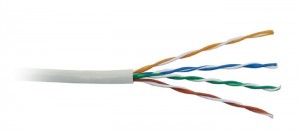Sometimes a simple piece of technology is so ingenious, it makes you wish you could meet the genius that came up with that idea. Simple twisted pair wiring is just that kind of idea.
Long wires work great as antennas, picking up all kinds of static and noise from their environment. That is bad for communications, where you only want the signal from the source to get to the receiver, without all the environmental noise.
The clever trick is to use something called differential mode transmission. You send your signal on one wire, and you send an inverted copy of the signal on a second wire that is right next to the first one. At the receiver, you invert one of the signals, and then add the two together.
Any noise that is picked up by the pair of wires will be inverted in one of the wires, so that when the signals are added, the noise from one wire will exactly cancel the noise from the other wire, leaving no noise at all. In contrast, adding the two signals will double the strength of the communication you care about.
In one trick, we reduce the noise to zero, and double the signal, giving us the high “signal to noise ratio” that is the holy grail of communications engineers.
Of course, if we have a bundle of wires all carrying different signals, some of them will be closer to one wire in the pair than to another, and we get a form of noise called “crosstalk”. But twisting the pairs eliminates that, because in a short distance, any signal induced by one wire in the pair is cancelled by the second wire, which the twist has brought closer to the other pair.
Just twisting isn’t quite enough, however, since if all the pairs had the same number of twists per inch, there would still be some correlation in the signals, and some crosstalk. But if you look closely at the photo above, you will see that each pair has a different number of twists per inch.
A side benefit from differential mode transmission is that it radiates less energy in the form of radio waves into space. The nearby opposite signals absorb one another, so less power is needed to send a signal the same distance in the cable, and less interference is transmitted to other cables.
So who was the genius who came up with this idea? Did he get fabulously wealthy?
As with many of these stories, the answer is that this stunningly brilliant idea didn’t occur to someone all at once, but took many iterations over many years to take form.
Telegraph lines and early telephone lines used a single wire to send the signal. The earth was used instead of a second wire. The circuit did not actually return to the battery through the earth, there would be far too much resistance. Instead, the earth, being a big object with lots of electrons, can simply absorb or emit as many electrons as are required.
When electric trolley cars were installed next to the telegraph wires, the sparks and current changes from the trolleys acted as strong nearby noise sources, and interfered with the signals. To get around this, telephone companies went to differential mode transmission, using two wires strung a couple feet apart on cross beams at the tops of poles.
This worked pretty well for trolley car interference, but as electrical power lines were installed carrying alternating current, a new source of interference came along. This was especially troublesome because the electrical wires were strung using the same poles as the telephone wires.
To get around this problem, the telephone wires were crossed every few poles. The power line interference was low frequency, so it had very long wavelengths. Crossing the phone wires every few poles had the same effect as a twisted pair for eliminating low frequency noise.
When telephone wires were bundled together, however, the noise was not just the low frequency power line noise, but higher frequency noise from the other phone signals. At this point, it made sense to twist the wires together a few times per inch instead of a few times per mile.
So now we have our familiar computer network cables, handling gigabits of information per second, all thanks to a bunch of telephone engineers solving one little problem after another.
I still hope someone got fabulously rich.
